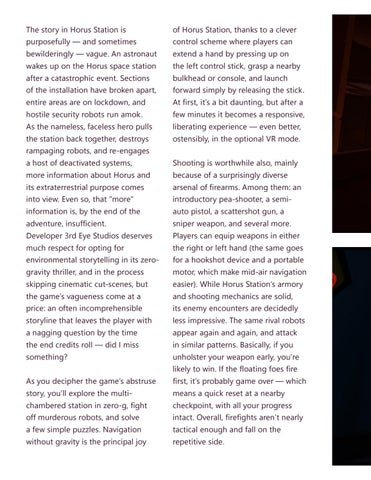The story in Horus Station is
of Horus Station, thanks to a clever
bewilderingly — vague. An astronaut
extend a hand by pressing up on
purposefully — and sometimes
wakes up on the Horus space station after a catastrophic event. Sections
of the installation have broken apart, entire areas are on lockdown, and hostile security robots run amok.
As the nameless, faceless hero pulls the station back together, destroys
rampaging robots, and re-engages
control scheme where players can
the left control stick, grasp a nearby bulkhead or console, and launch
forward simply by releasing the stick. At first, it’s a bit daunting, but after a
few minutes it becomes a responsive, liberating experience — even better, ostensibly, in the optional VR mode.
a host of deactivated systems,
Shooting is worthwhile also, mainly
its extraterrestrial purpose comes
arsenal of firearms. Among them: an
more information about Horus and into view. Even so, that “more”
information is, by the end of the adventure, insufficient.
Developer 3rd Eye Studios deserves much respect for opting for
environmental storytelling in its zerogravity thriller, and in the process
skipping cinematic cut-scenes, but the game’s vagueness come at a
price: an often incomprehensible
storyline that leaves the player with a nagging question by the time
the end credits roll — did I miss something?
As you decipher the game’s abstruse story, you’ll explore the multi-
chambered station in zero-g, fight off murderous robots, and solve
a few simple puzzles. Navigation
without gravity is the principal joy
because of a surprisingly diverse
introductory pea-shooter, a semiauto pistol, a scattershot gun, a
sniper weapon, and several more.
Players can equip weapons in either
the right or left hand (the same goes
for a hookshot device and a portable
motor, which make mid-air navigation easier). While Horus Station’s armory and shooting mechanics are solid,
its enemy encounters are decidedly
less impressive. The same rival robots appear again and again, and attack in similar patterns. Basically, if you
unholster your weapon early, you’re likely to win. If the floating foes fire
first, it’s probably game over — which means a quick reset at a nearby
checkpoint, with all your progress
intact. Overall, firefights aren’t nearly tactical enough and fall on the repetitive side.
